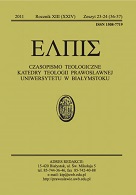Bizantyjski kanon ikonograficzny i jego adaptacja w krajach słowiańskich
Byzantine iconographic canon and its adaptation in Slavic countries
Author(s): Jerzy TofilukSubject(s): Christian Theology and Religion
Published by: Wydawnictwo Uniwersytetu w Białymstoku
Keywords: Iconography; iconographic canon; Byzantine iconography; Ermen; the script
Summary/Abstract: In the early centuries of Christianity, church art was loose. Over time, to protect the front of the influence of paganism, it was necessary to define the rules and regulations governing the writing of icons. Iconographic canon, as a set of rules and regulations, formed in Byzantium after the iconoclastic heresy, finally to the XI-XII centuries. Later, he was accepted by the other Orthodox Slavic nations. In the iconographic art of the Balkan countries and Russia, we find not only the adoption and appropriation of the Orthodox iconographic canon emerged in the Byzantine Empire, but also the expansion and enrichment. Byzantine art and Byzantine iconography can not be understood in the framework of one state or the people, they are associated with Orthodoxy and are a treasure trove of all the Orthodox Churches.
Journal: Elpis
- Issue Year: 2011
- Issue No: 13
- Page Range: 11-38
- Page Count: 28
- Language: Polish

